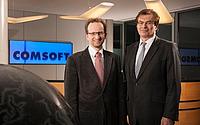- Information
- Mobility
SQAURING THE SKIES

Germany's largest airport, Frankfurt on the Main, records more than 1,300 takeoffs and landings every day. More than three million aircrafts fly in the airspace of the Federal Republic of Germany every year and there are around 80,000 flights worldwide every day. So, there is heavy traffic in the skies - but flying is still a safe way to travel. 4,500 fatalities in road accidents are offset by around 30 fatalities in air traffic each year in Germany. Air traffic control plays the biggest role in passenger safety. From the 'tower' - especially at large airports - takeoffs and landings are safely managed every minute. However, for small, remote airports in particular, the complex operation of telecommunications, navigation and positioning systems is a challenge
"We have developed a positioning system for civil aircrafts with the product name QUADRANT, which is very well suited as a supplement to the existing air traffic control system due to low investment costs and at the same time high reliability," say Manfred Schmid, CEO of COMSOFT GmbH, and Professor Uwe Hanebeck, Computer Science professor and Head of KIT Institute for Intelligent Sensor-Actuator Systems. The Karlsruhe-based company COMSOFT is one of the industry leaders in the field of air traffic management and has been a cooperation partner of KIT for many years.
Airspace surveillance organizes differently around the world. However, the fundamental technical basis is always radar surveillance. Radar antennas are distributed every 200 to 300 kilometers in Europe and North America. They transmit signals that either passively reflect back from the aircraft or actively respond to from the aircraft with additional information such as altitude. A position determined via the GPS satellite navigation system is also transmitted. However, the high risk of interference and the lack of accuracy in altitude information in particular make GPS technology not a reliable complement to radar. "Our surveillance system, on the other hand, uses multilateration, which is used, for example, at geographically isolated or topologically difficult airports. COMSOFT manufactures the systems, i.e., the receiving sensors and interrogation antennas. We at KIT have developed complementary software that uses existing signals to locate aircrafts more precisely than previous techniques can and is based on an independent technology," says Professor Hanebeck.
Multilateration is a cooperative surveillance technique that uses signals from transponders already installed in aircrafts. Multiple ground receivers pick up these signals. Because an aircraft's emission arrives at ground stations at different times, their signal responses arrive there at slightly different times. From these timing differences, aircraft positions can be accurately determined using complex calculations. "The problem until now, however, was that the receivers on the ground themselves were not one hundred percent precisely timed. The stations therefore had no absolute common time, but differed in the range of nanoseconds," says Hanebeck, a Computer Science professor. The seemingly minute time uncertainty leads to inaccuracies in the localization of the aircraft. For years, this coordination of ground station times posed a major challenge to the developers at COMSOFT and KIT, says Hanebeck: "The problem was the lack of a reference point that calibrates all stations with the same time. We then jointly developed the idea of using the aircraft themselves as the reference signal instead of specially set up measurement references." An astounding technological breakthrough that seems as impossible as squaring the circle: "We use the time difference of the incoming signals from several aircrafts to determine their time position at the receivers. This is a mathematical chicken-and-egg problem, so to speak, since both the transmission times of the aircraft and the exact reception times are unknown. This can only be solved with the help of a complex system of equations," explains the Computer Science professor.
The development and implementation of this mathematical clous in a software was an important milestone for the industry partner and was immediately filed for a patent. Manfred Schmid emphasizes how important the cooperation is for COMSOFT as well: "As a high-tech company in a niche market with a worldwide customer base, it is essential for us to be technologically at the forefront. We want to remain interesting and competitive for our customers. Our surveillance system is unique and is used by us worldwide - the developments of KIT are particularly valuable in this regard and provide us with another unique selling point." The latest developments from the partnership are already being used in the field, and together KIT and COMSOFT still have many plans, say Hanebeck and Schmid: "Since our competencies complement each other very well, we are further expanding our joint development activities."
"Impulses from science complement and enrich our pursuit of technological excellence 'Made in Germany'."
Images: KIT



